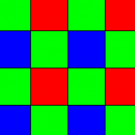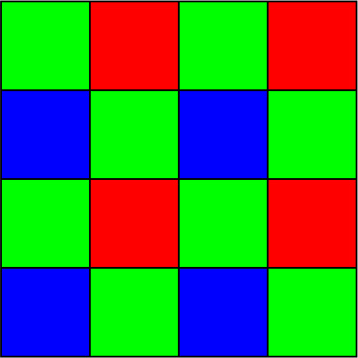-
Posts
321 -
Joined
-
Last visited
Content Type
Profiles
Forums
Articles
Everything posted by rawshooter
-
Neither. That's the problem. If you expose according to meters at 3200, you're actually two stops under. You will only see that when you import the CinemaDNG footage into Resolve. And "Profile off" doesn't help with that or change it in any way, unfortunately. That's why I wrote that we're talking past each other. The only workaround is to set the camera to ISO 800, meter, and then crank ISO up to 3200 while leaving aperture and shutter speed unchanged. But then you have a 2 stops overexposed camera display, no matter whether you're internally or externally monitoring. That's why I said that a custom LUT that pushes down external HDMI monitor display by 2 stops might be a workaround (but not really, since everything that will be clipped in the ISO 3200 preview display will still remain visually clipped.)
-

Raspberry Pi Releases an Interchangeable-lens Camera Module
rawshooter replied to androidlad's topic in Cameras
Hello @Anaconda_, can you help? I filed a bug report on the Github page of PyDNG's developer, along with your Dropbox links to the original camera files, and received the following answer from the developer: https://github.com/schoolpost/PyDNG/issues/24 -
The problem is that at no ISO except 100, the camera will correctly meter 15% grey... There is no internal false color, but even the external false color of a field monitor will be wrong because the camera sends out an HDMI signal with gain baked in on all ISOs except ISO 100. So the only workaround would be a monitor LUT that reverses that baked-in gain...
-
I think we're talking past each other. I'm referring to something else: The camera, in RAW, is ISO-invariant between ISO 100 and 2500, and from 3200 and above (the two native ISOs). So, clipping indicators for everything below ISO 3200 shouldn't change - but they do, because they meter Rec709 exposure with software gain applied instead of raw sensor exposure. Same happens at ISO 3200 - it's metering Rec709 gain, not the native ISO. And if you switch to ISO 6400, the camera will say that you're clipping one stop over ISO 3200 although this is factually not the case. This on top of ISO 3200 metering being incorrect re: raw sensor exposure. "Profile off" doesn't change any of that behavior.
-
This won't help because the video on the display (no matter whether internal or external) will be overexposed while the footage isn't. And a light meter and grey card are not really good for metering raw sensor exposure. The only workaround I see at the moment is to use an external HDMI monitor with user-uploadable LUTs, build a LUT that pushes the Rec709 picture into two stops underexpose, and rely on the monitor's zebras. But this will only work in ISO 3200. I think you're mistaken about the "none" mode. It is just a flatter Rec709 mode, with the same false exposure indication above ISO100 as all other color profiles of the camera.
-
That's unlikely to ever happen, since the Fuji cameras have X-Trans sensors, and no video software supports X-Trans debayering. As far as I know, ProRes Raw doesn't support X-Trans either.
-
Unfortunately not. There's currently no way of getting correct exposure indication from the camera except when you shoot at ISO100 (the camera's first native ISO). There, the clipping indicators (zebras and waveform monitor) are reliable for RAW, too, even when using standard color profiles. People are still looking into the question whether external RAW recording (BRAW with a BM Video Assist 12G HDR or ProRes RAW with an Atomos Ninja V) will yield correct external exposure metering as a welcome side-effect. (But then again, there's the problem of BRAW not really being an [undebayered] RAW signal, and ProRes RAW not being supported in Resolve and lacking standard RAW controls in all other programs except Assimilate Scratch.)
-

Canon 9th July "Reimagine" event for EOS R5 and R6 unveiling
rawshooter replied to Andrew Reid's topic in Cameras
Well, the footage is a throwback into old 5D Mark II days, with 90% out of it being out of focus... - And the rest shot at extremely high shutter speeds without ND filter, so anyone who thinks they can judge motion from this clip should just ditch the ND filter on the camera they're currently using... -

the BM 12K for S16. Is this the new S16 cam we all need
rawshooter replied to JimJones's topic in Cameras
200 lines in Super 16 are still 'only' a resolution of 1480p or 2.6K. -

the BM 12K for S16. Is this the new S16 cam we all need
rawshooter replied to JimJones's topic in Cameras
I wouldn't be so sure about the reframing room in S16 on the 12K Ursa vs. the Pocket 4K. In practice, it could be the opposite, since the 12K Ursa really is an oversampled 4K camera. With its 6x6 RGBW sensor pattern (versus the Pocket 4K's 2x2 Bayer pattern), you will need to downsample to 67% or less (i.e. create 2x2 pixels from a 3x3 sensor pattern, since only 3x3 pixels will contain R,G and B values) for a really usable image. That will yield the same resolution as the Pocket 4K in s16 crop... But you will be able to record glorious true RGB in 2K s16 with it, with no debayering at all... Which could finally surpass the image of the Digital Bolex. -

the BM 12K for S16. Is this the new S16 cam we all need
rawshooter replied to JimJones's topic in Cameras
Realistically though, the Blackmagic Pocket 4K with its 2.7K Super 16 crop recording mode should be more than enough. Even if you shoot with Zeiss Superspeeds, they will hardly resolve more than 2-3K. A 4K Super 16 camera will only yield a better resolution of lens blur and flares... Plus, the Pocket 4K's MFT mount is much more versatile for adapting non-PL-mount lenses that cover Super 16 (such as Canon V... zooms and TV16 lenses in c-mount, and Cooke Kinetal lenses in Arri STD mount). -
Can you tell which parameters you used exactly in LUTcalc? -F
-
On top of that, the 'artist' promoted in this clip is actually a children's book illustrator moonlighting as the cliché of what he thinks contemporary art is - while actually having zero credentials in the contemporary art system.
-
They do, in their product release video.
-
12K is more a marketing meme for the camera. Its real point is that it doesn't have a 2x2 Bayer matrix (as in my avatar on the left), but a 3x3 RGB matrix where all three colors are equally present. That means you will be able to downsample the 12K sensor signal into a 4K signal with no color interpolation by binning 3x3 pixels into one pixel. That's the equivalent of a 3-chip camera or Foveon sensor. Clean 4K with 4:4:4 color sampling and zero debayering artefacts. That's the real point (and news) of this camera. 12K is just marketing fodder for bloggers and influencers.
-
Same goes for me, I don't even want to know who these YouTube celebrities are and keep them out of my brain and life - just my 2 cents. (Just like I don't really want to know who the Kardashians are although I couldn't avoid hearing about them.)
-

Canon EOS R5 overheating vs Panasonic S1H and Sigma Fp designs
rawshooter replied to Andrew Reid's topic in Cameras
Sigma is a comparatively small family business, and AFAIK only assemble camera bodies in their own factory. The manufacturing of the electronics happens elsewhere. Since the fp uses Panasonic batteries (and the L-Mount co-engineered with Panasonic and Leica), one can almost be sure that the core electronics come from Panasonic, respectively the same factories that also produce the electronics for Panasonic cameras. -

Forum rules: No links to Cinema5D, DPReview, Nofilmschool
rawshooter replied to Andrew Reid's topic in Cameras
Just checked. They have it in the category "Entry Level Interchangeable Lens Camera / DSLR", with a number of cameras having equal scores and the Sony A6100 scoring better (82% vs. 79%). - I had the M100 in the past and must say that it's a very decent stills camera, especially in combination with the 22m/f2 pancake lens (which is as small as the smallest MFT cameras, but with an APS-C sensor, dual-pixel AF and a really good bang for the buck; as compact and as a good as a Fuji X100 if you shoot raw, but for a fraction of the price). -

Forum rules: No links to Cinema5D, DPReview, Nofilmschool
rawshooter replied to Andrew Reid's topic in Cameras
In all fairness, their 'award' system is based on camera categories, and they put the M6 and X-Pro 3 into different categories ("Mid Range Interchangeable Lens Camera / DSLR" for the M6 and "Semi-professional Interchangeable Lens Camera / DSLR" for the X-Pro3). Here's their explanation: https://www.*BAD_URL*/articles/4416254604/camera-scores-ratings-explained But it's still nonsense and garbage. High-quality tech review publications (such as the highly-regarded German computer magazine c't) never give awards and never declare "winners" in comparative reviews, but explain the individual strengths and weaknesses of particular products and let the reader decide. -
Apparently, the Olympus brand name will be dropped from cameras and lenses, and they will simply be sold as "OM-D", "Pen" and "Zuiko" with no other brand name. But that was to expected after the sell-off: https://www.43rumors.com/what-happens-next-2020-camera-and-lens-release-will-definitely-contonue-after-that-new-products-will-be-branded-as-omd-and-zuiko/
-

Canon EOS R5 overheating vs Panasonic S1H and Sigma Fp designs
rawshooter replied to Andrew Reid's topic in Cameras
This is not my point. My point is that Canon - as opposed to all other camera manufacturers that are not part of bigger electronics manufacturers (like Panasonic/Matsushita and Sony) literally manufactures its own chips, in its own three Japanese chip factories (they're listed on this Wikipedia page), which use completely dated processes and chip technology that is far behind current microchip technology. This is the reason why Canon's electronics and sensor performance has been behind the rest of the industry (which mostly uses Sony sensors), why they noe have bigger heat problems than the rest of the industry - but also why Canon has been more profitable than other camera manufacturers in the past (because it didn't need to buy its chips from other manufacturers). -
Yes, but only at ISO 100. All waveforms above ISO 100 actually meter sRGB/Rec709 for JPEGs/.mov instead of raw sensor exposure. If you rely on them, you'll underexpose the sensor/CinemaDNG material. To correctly expose the second native ISO 3200, you need to switch the camera to ISO 800 first, set exposure according to zebras/waveform/meter, leave aperture, shutter and ND as they are and switch ISO to 3200 (and live with a two stops overexposed camera display while recording :-(( ).
-
Unfortunately, it doesn't. "Color Profile: Off" is still a Rec709 curve, it only switches off the grading/styling. Otherwise, you'd had a much lower contrast picture on the camera's internal sRGB display. And if you have the camera set to the second native ISO 3200 and rely on its exposure tools - waveform, meter, zebras -, you will underexpose it by 2 stops. (You can easily control that by shooting 3200 with what the camera thinks is clipped exposure and importing the material into Resolve.)
-
Log would still be nice to have as a display profile to be able to properly monitor dynamic range and exposure of the camera in CinemaDNG - which now is guess work, especially at the second native ISO (3200).



